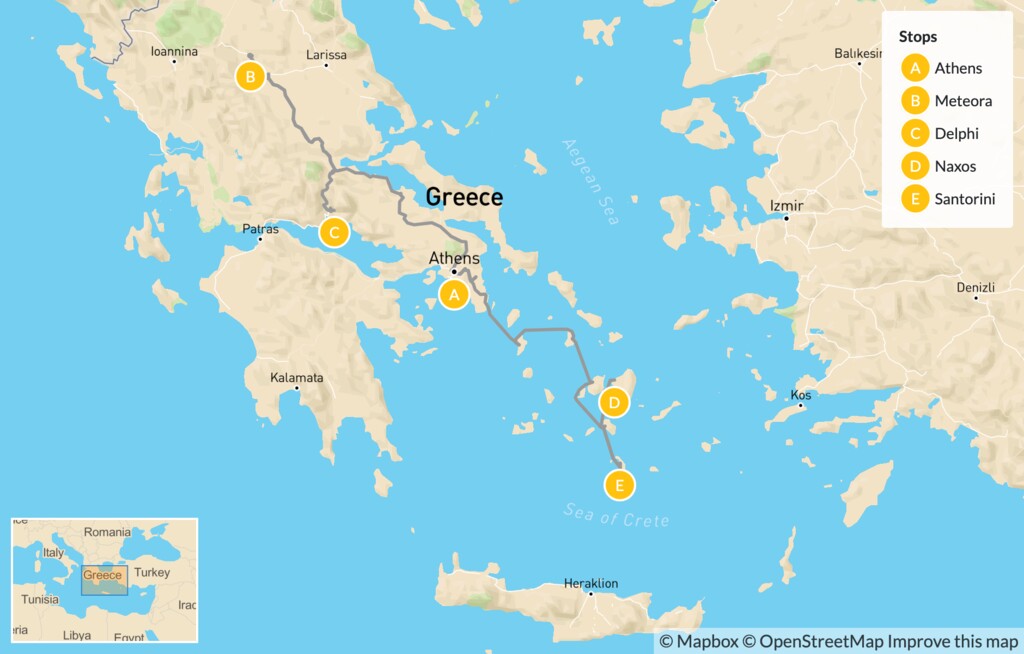Highlights
- Listen to Classical myths atop the Acropolis
- Ascend to the clifftop monasteries of Meteora
- Sample island cuisine with a food tour on Naxos
- See the sunset over Santorini's famous caldera
Brief Itinerary
| Day | Highlights | Overnight |
|---|---|---|
| Day 1 | Arrive in Athens & Explore Parks and Hills | Athens |
| Day 2 | Family Mythology Tour & Evening in Plaka | Athens |
| Day 3 | Olympic Games Workout & Transfer to Meteora | Meteora |
| Day 4 | Meteora Tour | Meteora |
| Day 5 | Meteora to Delphi & Family Activities on Mt. Parnassos | Delphi |
| Day 6 | Delphi Tour & Painting for Kids, Explore Galaxidi | Delphi |
| Day 7 | Delphi to Naxos | Naxos |
| Day 8 | Naxos Beaches, Food & Culture | Naxos |
| Day 9 | Day Trip to Delos & Mykonos by Boat | Naxos |
| Day 10 | Naxos to Santorini | Santorini |
| Day 11 | Oia Walking Tour & Beach Day | Santorini |
| Day 12 | Fishing Trip & Lost Atlantis for Families | Santorini |
| Day 13 | Santorini to Athens & Athenian Riviera Tour | Athens |
| Day 14 | Depart Athens |
Detailed Itinerary
Day 1: Arrive in Athens & Explore Parks and Hills

Day 2: Family Mythology Tour & Evening in Plaka
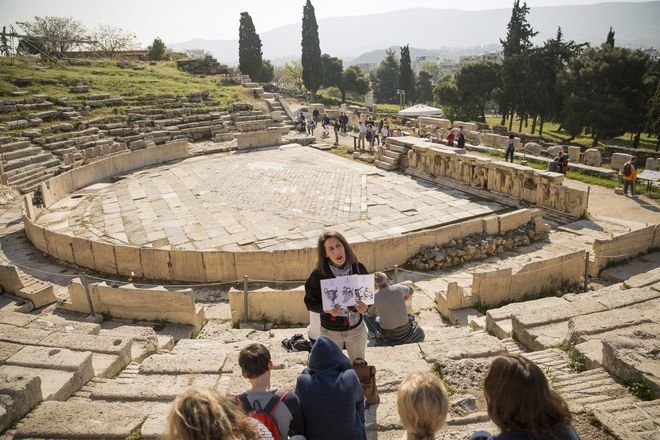
Explore the Acropolis and Ancient Agora with your family, learning about Greek mythology and history while enjoying kid-friendly activities and panoramic views of the city.
After meeting your guide, you'll start your walk up to Acropolis Hill, the "Sacred Rock" that defines Athens. You'll visit all its popular monuments, including the Parthenon, Theater of Dionysus, Temple of Athena Nike, and Temple of Erechtheion. Listen to the legends of the Greek pantheon, such as the mighty Zeus, Athena (goddess of wisdom), Poseidon (god of the sea), Dionysus (god of wine and theater), and more. The stories will keep kids entertained and asking questions.
After enjoying Acropolis Hill and learning the city's secrets, you'll walk down to the ancient marketplace, the Agora. Socrates and Plato hosted many political and philosophical discussions on this plaza. At the end of the tour, enjoy a family activity inside the ancient Agora, using all your newfound knowledge about Greek gods, goddesses, and heroes.
In the evening, head out for a walk through the Plaka neighborhood, the oldest and the most charming neighborhood of the city and ideal for an evening stroll. Trace the remnants of the city’s various stages at spots like the Roman Agora, the Old University, the Tower and Bath House of the Winds, the Benizelos Mansion, the Monument of Lysicrates, and all the lovely Byzantine churches. If you have the time, stop in at one of the two children’s museums, the Museum of Greek Children’s Art and the School Life & Education Museum.Day 3: Olympic Games Workout & Transfer to Meteora
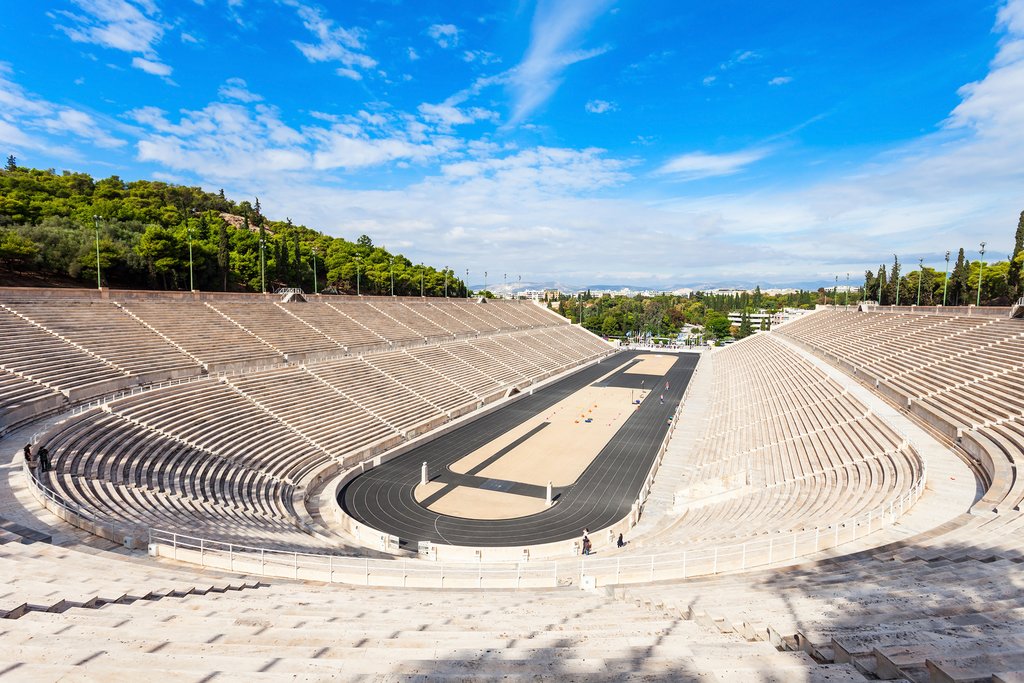
Get your blood pumping and try your luck as an Olympian at the very venue where the first modern Olympics took place in 1896. You’ll start your day at the Zappeion, a neoclassical building set just below the National Garden. Here, you’ll meet your trainer and learn how the ancient Olympics impacted society for over a millennium.
The year 1896 marked the revival of the ancient Olympic Games, which occurred every four years starting in 776 BCE. You’ll stand in the very spot where the athletes stood and learn how they trained, what the games entailed, and how the competition evolved.
After learning about the games, you'll start your workout in a historic gym. Your trainer will teach you some classic techniques from the original Olympic events, including the discus and the javelin throw. You'll also practice more modern sports, such as the shot put, long jump, and relay race.
All of your training will prepare you for your own competition—a race in the Panathenaic Stadium! This stadium is the only one in the world made entirely of marble. Following the hallowed track, you'll race around the arena before receiving your official certificate of participation.
Day 4: Meteora Tour

Discover the incredible scenery and explore the centuries-old monasteries on a private tour of historic Meteora, either in the cool morning hours or in the evening for sunset views. Reaching heights close to 2,000 feet (600 meters), Meteora is one of Greece's most important monastic communities. Your local guide will take you through this UNESCO World Heritage Site and explain its geological, cultural, and historical significance.
Home to some of the oldest monasteries in Greece, Meteora rises out of imposing rock formations created 60 million years ago. Enjoy a guided tour of ninth-century monastic life that has been nearly unaffected by modern times. You'll visit all six monasteries and enter two or three of them (depending on which are open and conditions that day). Along the way, your guide will continue to share historical information, local knowledge, and insider specifics. They'll offer plenty of photo stops and a few short walking excursions for the best views and hidden vistas.
Chat with a local specialist who can help organize your trip.
Day 5: Meteora to Delphi & Family Activities on Mt. Parnassos
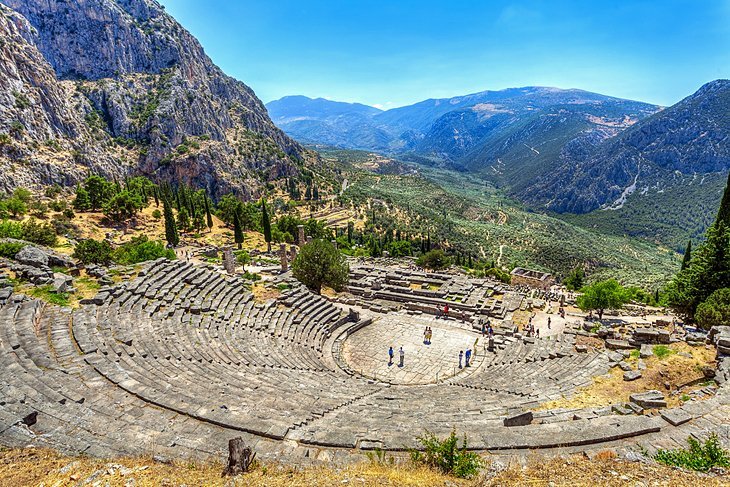
Enjoy one of the most beautiful road trips in Greece from Meteora to Delphi, a drive of roughly 3.5 hours.
Over the course of the drive, you'll traverse the hilly Domokos mountain range. This area is known for its creamy white cheese called katiki. You can stop at most towns for a quick snack or take the cheese with you (remember to keep it cool along the way). A potential stopping point along the way is Trikala, considered the most ecologically and sustainably advanced city in Greece.
Once you arrive, let your little ones explore the nature around Delphi with an easy walk through the National Park of Mt. Parnassos. Established in 1938, the park encompasses Mt. Olympus and stands as one of the country's oldest national parks. Enjoy walking through the forest, in fields, and amongst the wildflowers with your babies, toddlers, and young kids.
You'll walk along a circular path smooth enough to accommodate strollers. Along the way, your kiddos can peer into the entrance of the underground Eptastomos Cave. Deep inside sits the southernmost glacier in Europe, but the ancient Greeks considered it one of the entrances to the underworld.
Take a stop to enjoy a picnic with traditional delicacies while you get to know your guides. Discuss local traditions, try your hand at archery, or play and climb in the trees. You'll find two main tree species in this area: the Cephalonian Fir and the juniper tree.
On the way back, keep an eye out for little black squirrels hiding in pine trees and golden eagles soaring through the sky. The Ancient Greeks believed that Mt. Parnassos was the home of beautiful dancing forest nymphs that were the daughters of Gaia, also known as "Mother Earth."
Day 6: Delphi Tour & Painting for Kids, Explore Galaxidi

Day 7: Delphi to Naxos

You'll find hidden alleyways and courtyards, all exposing the daily routines of the locals. Overlooking the town of Naxos and atop a small hill is the Venetian Castle, or the Kastro as the locals call it. All the narrow, twisting streets seem to slowly pass through time, helping you travel back to the Venetian era as you ascend the castle.
Then, make your way down to the seafront promenade for a totally different look and feel. The waterfront is far more lively and cosmopolitan, connecting the island to the rest of the Cyclades. Stop for snacks or drinks while you wander, and don't miss the famous local cheeses—the island is one of the few places in Greece that produces cheese using cow milk. Parents can also sip on the locals' favorite liqueur, kitron.
As the sun starts to set, walk across a short causeway to the Portara, the Temple of Apollo's entryway. This is one of the best places to watch the horizon change colors and relax as dusk turns to night. The Portara is the only part of the temple that still stands today, proudly enduring on the islet of Palatia.
Day 8: Naxos Beaches, Food & Culture

Featuring smaller crowds than its Cycladic neighbors, Naxos makes it easy to find your own slice of paradise on its famed beaches. Whether you're looking for privacy, rustic beauty, or a lively scene, you can find it on Naxos.
Depending on your preferences, you have a few options for Naxos beaches.
- Agios Georgios. This beach is the closest option to the main town, offering easy access and proximity to cafes, restaurants, and shops. Generally filled with families, it's the perfect option for enjoying shallow waters and a bit more energy. An Aqua Fun Park for kids can be found in Stelida.
- Agia Anna & Agios Prokopios. Both beaches feature sweeping sandy banks and offer plenty of amenities, including chairs, umbrellas, and tavernas. With a lengthy shoreline, you can easily claim a spot and enjoy privacy. The shallow water makes them an excellent option for families and snorkeling. You can find pedal boats to rent.
- Plaka & Apollonas. Like Agia Anna and Agios Prokopios, these two beaches offer amenities, privacy, and family-friendly waters. However, they're slightly less crowded and provide a quieter reprieve.
If your family is on the sportier side, there are options for beginners' classes in kitesurfing, windsurfing, and scuba diving as well.
Once you've soaked up sufficient sun, head out on a private tour to explore Naxian culture and food. The countryside of Naxos island has some of the best local produce and food in the Cyclades.
You'll start in the charming village of Kaloxylos, where you'll visit a local home. Chat with your hosts over the age-old tradition of Greek coffee and dessert and learn about traditional Naxian cuisine and daily life in rural Naxos. Join your host on a stroll through the village, tasting a few items and collecting ingredients for a typical Naxian dish.Next, make your way through the other villages, which include Filoti, Apeiranthos, and Chalki. Enjoy a local cheese tasting and sample traditional recipes as you stroll through the narrow streets. Meet with local producers and learn more about what makes Naxian produce, olive oil, meats, and dairy products so significant to the whole of Greece.
You'll end your tour with a visit to a kitron liquor distillery to see its production in action and taste the traditional spirit of Naxos.
Day 9: Day Trip to Delos & Mykonos by Boat

Delos played a significant role in the ancient world of the Cyclades. It's the birthplace of two Greek gods, Apollo and Artemis, and it became home to the first multicultural civilization in the world. You'll walk around the archeological site with a dedicated guide, learning about the island's fascinating history, culture, and why it was such an important trade center.
You'll weave through the foundations of prehistoric mansions, temples, and landmarks, such as the Terrace of the Lions. Afterward, pop into the island museum, which hosts an extensive collection of small artifacts and frescoes. When you're finished, you'll head back to the boat and make your way toward lively Mykonos.
As an active cosmopolitan hub, Mykonos couldn't be more different from Delos. The island is known for its blue and white cubic houses, narrow streets, and the picture-perfect "Little Venice" neighborhood along the waterfront. You'll also find Greece's famous windmills in Mykonos, the perfect place to capture the essence of the Cyclades. Enjoy plenty of free time to roam around the main town, exploring its streets, finding viewpoints, and relaxing at one of its cafes.
Day 10: Naxos to Santorini

Take a 1.5-hour high-speed ferry from Naxos to the famous cliffs of Santorini.
There's nothing like a Santorini sunset, as the island's viewpoints are some of the Cyclades' best. It isn't easy, however, to find a spot without extreme crowds. Get off the beaten path and discover the hidden go-to's so you can have the views mostly to yourself.
Perhaps the best way to enjoy the caldera views is along the Fira to Oia Walking Path. This route runs underneath the island's main road, offering a peaceful and quiet stroll while enjoying endless, uninterrupted views. You don't have to trek the entire trail to reap the benefits; a great entry point is at the Pantheon between Imerovigli and Oia. From here, enjoy a short, easy, and mostly downhill walk with excellent views.
One of the island's best spots for sunset is Skaros Rock, an impressive rock formation that juts out into the sea. The views require a short hike from the trailhead at Imerovigli, so wear some sturdy shoes. The terrain is rocky, so pay attention to where you step, especially when returning from sunset after dark.
If you're interested in savoring those perfect panoramic views of Santorini without the crowds, visit the Monastery of Prophet Elias. This is the highest point on the island, so you'll get a 360-degree view of the sea, rocky cliffs, and white-washed villages. Before making the drive, take a peek at the weather report, as it tends to get a little foggy at the top.
To catch views of Santorini's entire crescent-shaped caldera, you can hop on a quick 30-minute ferry to Thirassia (departing from Ammoudi). Thirassia is one of the remote volcanic islands set within the crater. To get the best views, leave the small port and walk up to the village. On the way, you’ll enjoy scenes of the entire caldera from a unique vantage point.
Day 11: Oia Walking Tour & Beach Day
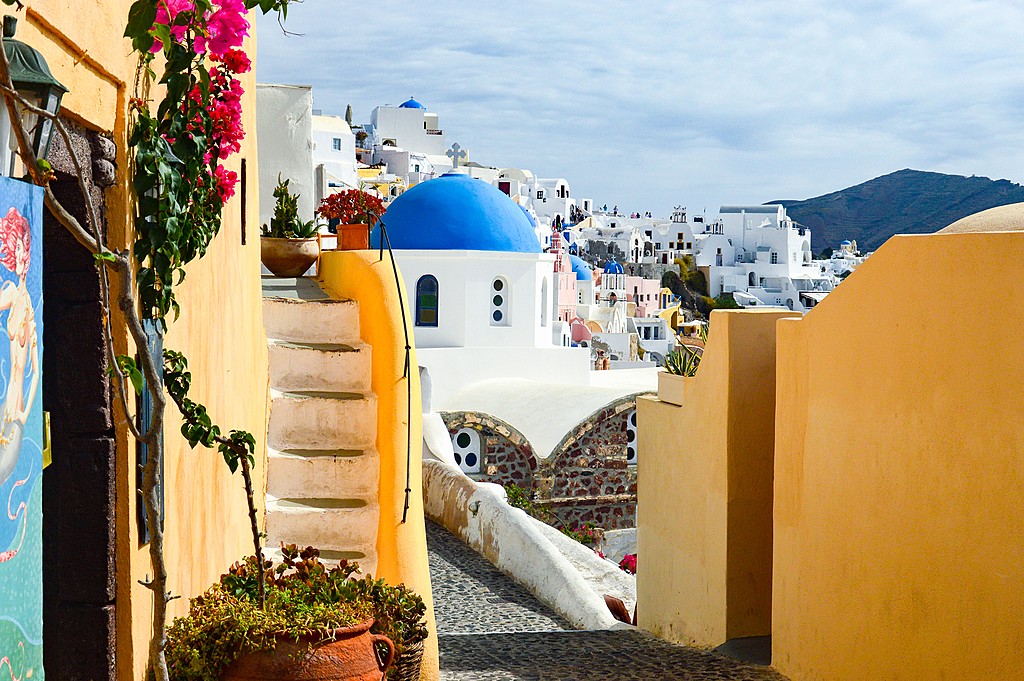
Explore Oia, Santorini's picture-perfect village, with a private, local guide. Dramatically perched atop the cliffs of the caldera, this scenic town contrasts famously against its natural surroundings. Rusty rocks and azure-blue waves complement its pastel cave houses, whitewashed facades, and colorful harbor. Enjoy strolling through the charming streets while admiring the views over the caldera and volcanic islands.
As you walk through the main streets and back alleyways of this enchanting village, your guide will make several stops to point out exceptional viewpoints and interesting island history. Listen to stories about Oia's culture and heritage, then discover the picturesque fishing harbor of Ammoudi. You'll descend 300 steps along the caldera's rim, ending at a small port untouched by time.
Afterward, it's time to hit the beach. Most of the island's banks feature dark volcanic sand in black and red hues, contrasting perfectly with the deep blue sea and whitewashed villages. Enjoy relaxing, swimming, or snorkeling in the surreal scenery, but don't forget your sandals or water shoes, as the dark sand becomes incredibly hot in the midday sunshine.
Santorini is home to several beach options. For families, try Kamari Beach, the most upscale and touristy of Santorini's beach towns with a fun and family-friendly vibe. The beach's black sand and pebbles stretch for over three miles, providing numerous restaurants, cafes, and bars. You'll also find places to rent jet skis or snorkeling and scuba diving equipment.
For somewhere a little less busy, Monolithos Beach is home to Santorini's best sand and the most family-friendly beach on the island. It offers a quiet and relaxed vibe with a just small cluster of hotels and restaurants. You can rent umbrellas and loungers and enjoy watching the white-capped waves flow onto the shore.
Day 12: Fishing Trip & Lost Atlantis for Families

Experience Santorini's famed seafood aboard a traditional fishing boat while eating the catch-of-the-day for lunch or dinner with a fishing trip that can take place either first thing in the morning or in the evening. You'll start your excursion at Vlychada Marina. As you head for one of the deepest and most diverse spots in the Aegean Sea, your boat will release nets and creels in hopes of catching shrimp and octopus.
Your expert guide will teach you about the island's traditional fishing methods and help you get acquainted with your equipment. After learning a few basic techniques, you'll try your luck in the water. Whatever the ship catches, you'll enjoy for a meal!
After fishing, you'll dock at a gentle harbor where the crew will prepare your seafood. While you wait, enjoy swimming or snorkeling in the sea. If you haven't snorkeled before, your guide is happy to help you learn some diving and breathing techniques.
If you choose to take an evening trip, after dinner, you'll return to the open sea and watch a famous Santorini sunset. Enjoy views of the caldera as the sun melts in the sea before returning to Vlychada.
Before or after your time on the water, depending on how you choose to schedule your day, learn the story of Lost Atlantis. Live the myth at the new experiential museum in Santorini, the only museum about Lost Atlantis in the world. You can learn about the myth of Atlantis, how it is connected to Santorini, experience its destruction, and explore multiple digital installations.
Then continue to the possible inspiration behind the legend at Akrotiri, one of the most significant prehistoric settlements of the Aegean Sea. This archaeological site features an ancient city preserved by volcanic ash for thousands of years. You'll walk through the city's remarkably preserved ruins and learn why this site played such an essential economic role. Stroll amongst the ancient walls of the houses and learn what the inhabitants did each time the volcano erupted, how they took their ships out to sea only to return and rebuild their settlement from scratch.
Day 13: Santorini to Athens & Athenian Riviera Tour

You can make an optional stop here to visit the Neraida Floating Museum, which narrates the business career of the ship’s owner, John Latsis, as well as the history of the ship from its construction in 1939 to the completion of its reconstruction in 2010. If you and your kids love ships and boats, and especially battleships, do not miss the opportunity to visit the Park of Naval Tradition inside the marina. Historic vessels are docked there, such as the destroyer “Velos” (now a museum of the struggle against the military dictatorship), the only copy of an ancient trireme named “Olympias” and the cable-laying ship “Thales of Miletus’ constructed in the U.S. in 1909.
Further south, another optional stop is at the rescue and rehabilitation center for sea turtles, run by the Sea Turtle Protection Society of Greece in Glyfada. Its purpose is to treat injured and sick sea turtles and eventually release them back into the sea, as well as to raise awareness regarding this rare species that reproduces in the endless sandy beaches of the Mediterranean Sea. Take part in the sea turtle rescue tours, adopt a sea turtle for 10 days, and enjoy a meal on the Glyfada beach.
The tour ends at the tip of Cape Sounion, home to the famous Temple of Poseidon that overlooks the Saronic Gulf and its islands. Before heading back to the city, you can opt for an early dinner at a traditional taverna right on the beach. Enjoy fresh seafood caught just a few feet from where you're sitting, plus good company and the sound of the waves lapping the shore as you watch the sunset.
Day 14: Depart Athens



